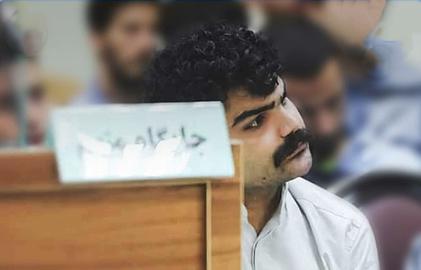“Mr M” is not exactly Lincoln Burrows, the character from the popular television series Prison Break, but nonetheless, he is famous in Iran as the only prisoner known to have escaped from Rajai Shahr Prison. Unlike Burrows, who had the help of his brilliant brother Michael Scofield, M fled one of Iran’s most secure prisons by relying only on his own patience and ingenuity.
His story is regularly told throughout the corridors of Rajai Shahr, which houses approximately 10,000 inmates, although prison officials refuse to publicly acknowledge what happened. Those who shared a ward with M are only too aware that a fellow inmate they used to see on a daily basis is no longer there, and is enjoying freedom somewhere beyond the confines of the prison.
Mr. M did not escape by taking advantage of an accident, or due to the negligence or mistakes of prison guards. He had an ingenious plan and, according to all acccounts, carried it out meticulously.
Before his escape, Mr M was a common criminal, no different from many others at Rajai Shahr. But now his experience has turned into an epic tale of freedom and inspiration for those left behind.
Mr. M had been given a death sentence. Although his fellow inmates knew he had been found guilty of murder — he was housed in the ward reserved for murderers — they knew very few details about his crime. He did not talk much and formed no friendships while in prison. His ward-mates describe him as calm and withdrawn. He lived in a small cell by himself.
An inmate named Navid met him in prison. “When I first heard about it I was shocked. But after a while, when it sank in, I was really happy,” he says. “He planned it in silence and did not just wait to be executed. His death sentence had recently been reduced to life in prison, but it appeared very likely that the appeals court have would re-instituted the death sentence. So he dug his tunnel and didn't wait. His ingenuity amazed us all.”
“Digging a tunnel in Rajai Shahr Prison is not easy,” says Saleh, another of Mr. M’s ward-mates.“There is a tunnel underneath the prison almost a kilometer long, designed for visitors to use. Every day, the families of the prisoners walk the length of it to meet with inmates. So digging a tunnel from a cell is not only not simple, but requires a good, detailed map. A person would need to avoid ending up in the visitors’ tunnel, and would need to make sure they didn’t accidentally damage the prison’s water or sewer system and get caught. And suppose they did start digging the tunnel. With inspections by prison guards every other week, it would be next to impossible.”
A tunnel, a map, and a change of clothes
But according to Saleh, Mr. M took all these factors into account. He dug a small tunnel going toward the visiting hall. I asked him about the distance between Mr. M’s cell and the hall and he said it was about 20 meters. But how can a prisoner dig through 20 meters of masonry all by himself using primitive tools? How could he escape notice during the periodical inspections?
“That's the point,” Saleh says. “He did not dig a 20-meter-long tunnel. A gurgle of water made him realize that the sewage system ran right under his cell. He got his hands on a plan of the prison’s sewage system and had to dig a meager couple of meters to get to the sewage system — and then to freedom.”
But how did Mr. M get the plans of the sewage system? “He was a clever fellow, so the prison had him work on technical installations and sometimes in the workshop,” Navid says. “He saw a repairman holding the plans and somehow made a copy of them. He had volunteered to work with the prison’s service team and had good working habits. He could have acquired the needed tools while working with the same service group. He rarely talked, but he was always looking carefully around him. Later I learned that he knew exactly what he was doing and knew which sewage trapdoor in the visiting hall would not expose him to the visitors and the surveillance cameras.”
One visitors’ day, Mr. M wrapped his suit in a plastic bag and hung it around his neck. Most probably he changed his clothes after walking 20 meters through mud and sewage pipes. When he entered the visiting hall he was not carrying anything. He pretended to be the family member of an inmate who had come to visit. He joined the crowd of visitors and left the prison with them.
Farzad, an inmate who also works with the service team of the prison, says now he understands Mr. M’s odd behavior. “When everybody learned about his escape, we all started analyzing his plan,” he says. “He was smarter than we would have been. He put all the scattered pieces of the puzzle together and came up with a workable plan. I had imagined that you could dig to the big tunnel under the prison, but I couldn't come up with a practical and workable plan.”
Farzad says inmates regularly talk about escape, but they never come up real schemes for escape. “I have thought many times about escaping through the visiting hall. But to be honest, I never found the courage to try.”
I asked Farzad how Mr. M managed to dig the tunnel in his cell and keep it a secret. “He was very careful to hide it from the inmates,” he says. “He told us he was suffering from migraines and the only way to deal with it was by having silence and solitude. He would not leave his cell for hours and used that time to dig into the floor toward the sewage system. His cell was two by two meters and had a dishwashing sink that emptied into the sewage system. Mr. M patiently started digging from under the sink and mixed the dust with water to dispose of it through the same sink. He knew that his cell was not more than 20 meters away from the visiting hall because he had walked the distance.”
Nobody knows how Mr. M felt when he went through the tunnel or as he passed by the inspection booth at the gates — though they can all imagine. Not long after, no one could find him. Prison guards found his wet, dirty clothes at the end of the tunnel.
Mr M is now somewhere out in the world, no doubt enjoying his cunning ingenuity and unbelievable success.
Read more from Fereshteh Nasehi'sseries
visit the accountability section
In this section of Iran Wire, you can contact the officials and launch your campaign for various problems


























comments